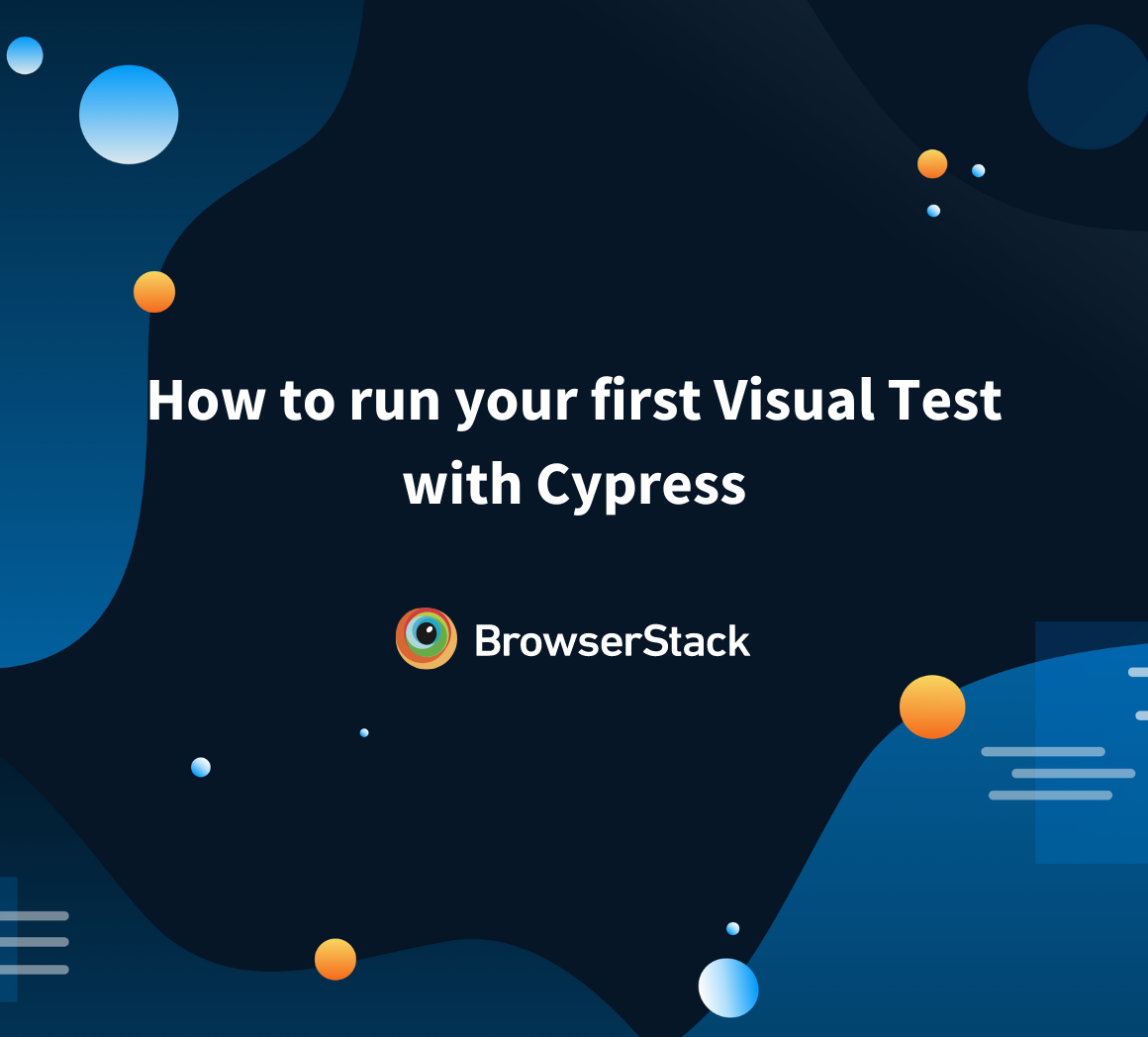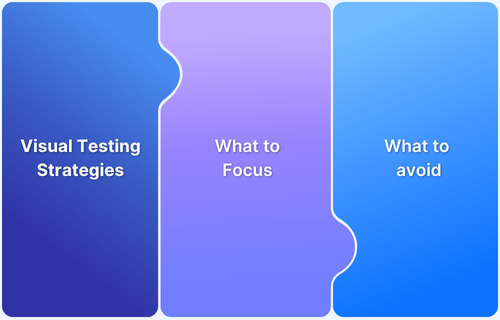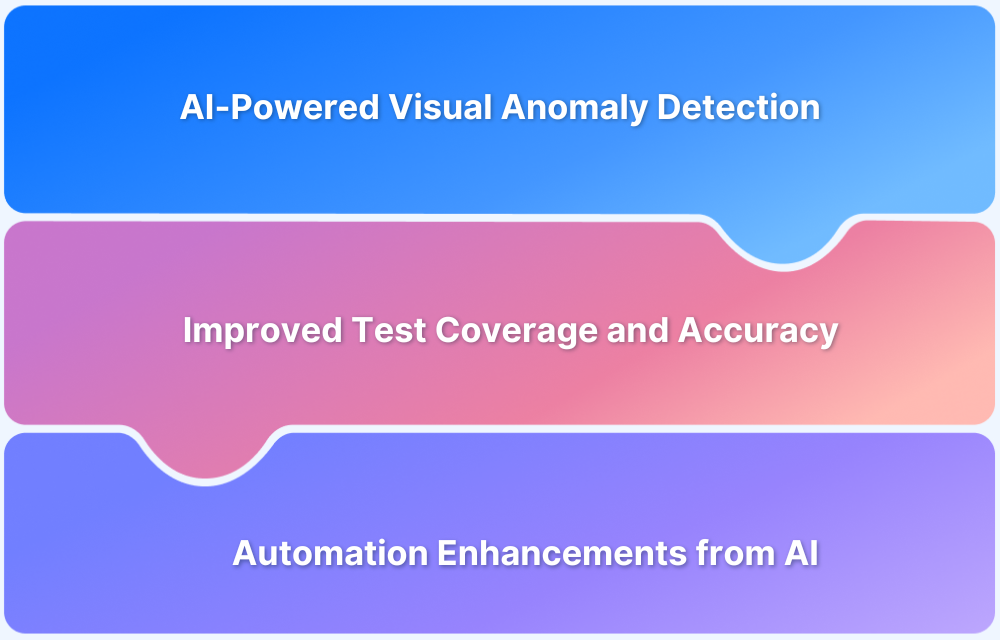Software interfaces are increasingly dynamic and visually rich, where even minor layout shifts or broken elements can harm user trust. Manual testing often misses these subtle issues, but AI visual testing automates detection of unintended UI changes with intelligent image comparison.
Overview
How AI Visual Testing Works
- Snapshot Capture: AI tools take screenshots of the application’s UI during tests.
- Baseline Comparison: Captured snapshots are compared against predefined baseline images.
- AI-Powered Analysis: Computer vision algorithms detect contextual differences like misaligned buttons, text changes, or broken images.
- Bug Detection: Discrepancies are flagged, highlighting specific visual issues for developers.
Benefits of AI Visual Testing
- Reduces Human Error: Catches subtle visual issues that manual checks often miss.
- Improves Accuracy: Context-aware analysis reduces false positives compared to pixel-based methods.
- Increases Speed & Efficiency: Automates testing, enabling faster execution across devices and browsers.
- Catches UI Issues: Detects layout shifts, color changes, and misplaced elements impacting user experience.
- Enhances User Trust: Maintains a consistent, professional UI that builds credibility and engagement.
This article explains the role of AI Visual Testing in maintaining visual accuracy, how it differs from traditional methods, and the key benefits it brings to development and QA workflows.
Importance of AI Visual Testing in Modern Software Development
AI visual testing ensures UI accuracy and consistency across devices and browsers. It automates detection of subtle visual issues that manual testing often misses, speeding up releases and reducing regressions.
Why AI visual testing matters in modern development:
- Accelerates release cycles: Automates visual validation, reducing manual review time and supporting faster deployments.
- Maintains cross-platform consistency: Detects visual differences across devices, browsers, and resolutions for a uniform interface.
- Enhances accuracy: Identifies pixel-level or layout inconsistencies that human testers may miss.
- Improves collaboration: Generates visual reports that help developers, designers, and QA teams resolve issues efficiently.
AI visual testing has become critical for teams that value accuracy, scalability, and consistent user experience across modern digital products.
Must Read: AI Visual Testing Tools
Visual Testing vs AI Visual Testing
Visual testing helps verify how a user interface appears after a code change. It compares screenshots of the application to detect layout shifts, broken elements, or design inconsistencies.
AI visual testing takes this process further by analyzing visuals intelligently to identify meaningful UI changes while ignoring trivial differences.
| Aspect | Traditional Visual Testing | AI Visual Testing |
| Comparison Method | Pixel-by-pixel comparison | Context-aware analysis using visual recognition |
| Accuracy | Sensitive to small, irrelevant variations | Detects meaningful UI changes only |
| False Positives | High, due to rendering or anti-aliasing differences | Low, filters out insignificant variations |
| Setup Effort | Manual configuration of screenshots | Automated capture and analysis across builds |
| Maintenance | Frequent baseline updates needed | Smarter baseline management with reduced noise |
| Scalability | Limited in large projects | Scales easily across browsers and devices |
| Integration | Requires custom scripting for automation | Integrates directly with CI/CD pipelines |
| Output Clarity | Raw image differences | Annotated reports with highlighted differences |
Benefits of Implementing AI Visual Testing
AI visual testing strengthens software quality in multiple ways. From detecting subtle UI issues to ensuring cross-platform consistency, here are 6 key benefits of AI visual testing.
- Faster Release Cycles: Automates UI snapshot comparisons and integrates with CI/CD pipelines, enabling instant layout validation and quicker releases.
- Higher Detection Accuracy: Detects subtle visual issues like layout or color inconsistencies that traditional methods often miss, reducing production bugs.
- Cross-Platform Consistency: Validates visuals across browsers, devices, and screen sizes, ensuring uniform user experience and design stability.
- Reduced False Positives: Focuses on meaningful UI changes, ignoring irrelevant pixel differences, so QA teams address only real issues.
- Scalable Regression Coverage: Automatically validates hundreds of screens and new components, maintaining regression coverage for agile releases.
- Better Collaboration and Traceability: Provides annotated before-and-after screenshots, making it easier for teams to communicate, resolve defects, and track visual changes over time.
How AI Visual Testing Works
AI visual testing automates visual validation, catching problems that humans can miss while keeping testing consistent at scale. Here’s how it works:
- Baseline Capture: Take reference screenshots of a correct UI (e.g., login page buttons, fields, icons) to serve as the standard.
- Test Execution: Automated screenshots run on multiple browsers, devices, and resolutions for each build to verify consistency.
- Intelligent Comparison: AI compares new screenshots to baselines, ignoring trivial differences and highlighting meaningful changes like misaligned buttons or missing images.
- Change Classification: Detected issues are categorized like layout shifts, missing elements, text overflow, color mismatches, helping teams prioritize fixes.
- Reporting: Annotated visual reports clearly show changes, speeding up debugging and collaboration.
- Baseline Update: Intentional UI updates replace the old baseline to maintain accurate future validations.
Also Read: Top 17 Visual Testing Tools in 2025
Key Features of AI Visual Testing Tools
To get the most value from AI visual testing, choose a tool that includes the key features outlined below. These features help detect visual defects accurately, maintain UI consistency, and streamline testing workflows.
- Smart Visual Comparison: AI visual testing compares UI elements intelligently rather than pixel by pixel. It identifies meaningful differences, reduces false positives, and focuses on changes that affect user experience.
- Cross-Browser and Cross-Device Testing: These tools validate layouts and functionality across multiple browsers, devices, and screen sizes. This guarantees a consistent experience for all users regardless of platform.
- Baseline Management: Stores reference screenshots to compare against future builds. This helps track visual changes over time and quickly identify regressions after updates or redesigns.
- CI/CD Integration: Integrates with continuous integration and delivery pipelines. Visual tests run automatically with each build, catching defects early and reducing production errors.
- Automated Screenshot Capture: Captures snapshots of UI pages and components without manual effort. Provides comprehensive coverage, reduces human error, and accelerates testing cycles.
- Collaborative Reporting: Generates annotated reports highlighting visual differences. Teams can review, discuss, and resolve issues faster, improving collaboration between QA, developers, and designers.
- Dynamic Element Handling: Masks or ignores elements that change frequently, such as ads, timestamps, or dynamic content. This stabilizes results and minimizes false positives during automated testing.
Top AI Visual Testing Tools in 2025
Each of the AI visual testing tools comes with a unique set of features designed to detect UI regressions and maintain consistent user interfaces. Here are the top five tools in 2025 that are leading the space.
1. BrowserStack Percy
Percy by BrowserStack is an AI-powered visual testing platform designed to automate visual regression testing for web applications, ensuring flawless user interfaces on every code commit.
Integrated into CI/CD pipelines, Percy detects meaningful layout shifts, styling issues, and content changes with advanced AI, significantly reducing false positives and cutting down review time for fast, confident releases.
- Effortless Visual Regression Testing: Seamlessly integrates into CI/CD pipelines with a single line of code and works with functional test suites, Storybook, and Figma for true shift-left testing.
- Automated Visual Regression: Captures screenshots on every commit, compares them side-by-side against baselines, and instantly flags visual regressions like broken layouts, style shifts, or component bugs.
- Visual AI Engine: The Visual AI Engine uses advanced algorithms and AI Agents to automatically ignore visual noise caused by dynamic banners, animations, anti-aliasing, and other unstable elements. It focuses only on meaningful changes that affect the user experience. Features like “Intelli ignore” and OCR help differentiate important visual shifts from minor pixel-level differences, greatly reducing false positive alerts.
- Visual Review Agent: Highlights impactful changes with bounding boxes, offers human-readable summaries, and accelerates review workflows by up to 3x.
- No-Code Visual Monitoring: Visual Scanner allows rapid no-install setup to scan and monitor thousands of URLs across 3500+ browsers/devices, trigger scans on-demand or by schedule, ignore dynamic content regions as needed, and compare staging/production or other environments instantly.
- Flexible and Comprehensive Monitoring: Schedule scans hourly, daily, weekly, or monthly, analyze historical results, and compare any environment. Supports local testing, authenticated pages, and proactive bug detection before public release.
- Broad Integrations: Supports all major frameworks and CI tools, and offers SDKs for quick onboarding and frictionless scalability.
Pricing
- Free Plan: Available with up to 5,000 screenshots per month, ideal for getting started or for small projects.
- Paid Plan: Starting at $199 for advanced features, with custom pricing available for enterprise plan.
2. Katalon Studio
Katalon Studio is an end-to-end test automation solution offering AI-powered visual testing capabilities. It provides pixel-based, layout-based, and content-based image comparison methods, allowing teams to detect visual regressions and ensure UI consistency across applications.
Key Features of Katalon Studio:
- AI-Powered Test Maintenance
- Cross-Browser Testing
- Integration with CI/CD Tools
- Data-Driven Testing
- Scriptless Test Creation
- Test Analytics
Use Cases of Katalon Studio:
- Automating UI tests for web and mobile applications
- Testing API endpoints for consistent functionality
- Detecting visual and functional regressions in updates
- Managing test maintenance with AI-assisted features
Katalon Pricing: Katalon offers both free and paid plans:
- Free: $0
- Create: $84/user/month (annual plan)
- Expand: $168/user/month (annual plan)
- Scale: Custom Pricing
Verdict: Katalon Studio AI visual analysis tool provides a comprehensive automation suite, however, its enterprise features can become costly for large teams.
Read More:Katalon Alternatives
3. TestGrid
TestGrid is a test automation platform offering AI-powered visual testing features. It enables teams to verify an application’s visual appearance by comparing it to a baseline image, ensuring UI consistency and detecting visual regressions across various browsers and devices.
Key Features of TestGrid:
- Real Device Testing
- Scriptless Test Creation
- Parallel Test Execution
- Integration with CI/CD Tools
- Visual Regression Detection
- Test Analytics
Use Cases of TestGrid:
- Running mobile app tests on real physical devices
- Testing web applications across multiple browsers
- Detecting functional and visual regressions efficiently
- Simplifying maintenance with scriptless test creation
TestGrid Pricing: TestGrid offers five pricing editions:
- Freemium: $0
- Manual Testing: $25/Month
- End-to-end Automation: $99/Month
- Private Dedicated: $30/Month
- Enterprise: Custom pricing
Verdict: TestGrid AI visual analysis tool offers a range of testing features, however, its user interface and documentation may not be as intuitive as competitors.
4. Mabl
Mabl is an AI-native test automation platform that empowers software teams to accelerate innovation while ensuring exceptional quality. It offers visual change detection capabilities to monitor key pages in applications, identifying visual regressions and ensuring consistent user experiences across browsers.
Key Features of Mabl:
- AI-Powered Test Maintenance
- Cross-Browser Testing
- Integration with CI/CD Tools
- Test Analytics
- API Testing
- Visual Regression Detection
Use Cases of Mabl:
- End-to-end UI testing for web applications
- Validating API behavior during development cycles
- Detecting visual regressions in automated workflows
- Reducing maintenance using self-healing test automation
Mabl Pricing: Mabl offers customized pricing based on test coverage and scalability needs.
Verdict: Mabl AI visual analysis tool integrates well with CI/CD pipelines and offers self-healing tests, however, some users report false positives and occasional instability.
Also Read: Mabl Alternatives
5. TestComplete
TestComplete is a test automation platform that provides AI-powered visual testing capabilities. It enables teams to perform visual regression testing by comparing screenshots and detecting UI discrepancies, ensuring consistent user interfaces across applications.
Key Features of TestComplete
- AI-Powered Visual Testing
- Cross-Platform Testing
- Scriptless Test Automation
- Advanced Object Recognition
- Parallel Test Execution
- CI/CD Integration
Use Cases of TestComplete:
- Automating desktop, web, and mobile UI tests
- Detecting visual or functional regressions early
- Running tests across multiple browser environments
- Managing and maintaining reusable test scripts
TestComplete Pricing: TestComplete offers a range of pricing options:
- Base: $4,108 (Includes desktop, mobile, and web testing.)
- Pro: $7,799 (Includes all modules at a bundled price.)
- Advanced: Custom Pricing
Verdict: TestComplete AI visual analysis tool supports various scripting languages and platforms, however, its pricing can be prohibitive for smaller teams.
6. Visual Regression Tracker
Visual Regression Tracker is an open-source tool that helps teams manage visual regression testing. It integrates with various testing frameworks and provides a dashboard to review visual changes, ensuring UI consistency and detecting visual regressions across applications.
Key Features of Visual Regression Tracker
- Open-Source Solution
- Baseline History Tracking
- Ignore Regions Functionality
- Multi-Framework Support
- User Authentication
- REST API Integration
Use Cases of Visual Regression Tracker
- Monitoring visual changes in web applications over time
- Comparing screenshots across multiple browsers
- Detecting layout changes after UI updates
- Tracking visual inconsistencies during releases
Visual Regression Tracker Pricing: Visual Regression Tracker offers three pricing options as follows:
- Open Source: $0 (Community-supported version)
- Pro: $1,200/year (Includes additional features and support)
- Enterprise: Custom (Tailored solutions with dedicated support)
Verdict: Visual Regression Tracker AI visual analysis tool specializes in visual regression tracking, however, it lacks comprehensive test automation features, limiting its standalone utility.
7. Functionize
Functionize is an intelligent test automation platform that uses AI and machine learning to drastically speed up testing time. It generates a visual model of your application using data collected during test creation and compares subsequent test runs against this baseline to identify any test failures or anomalies.
Key Features of Functionize:
- AI-Powered Test Creation
- Self-Healing Tests
- Cloud-Based Execution
- Integration with CI/CD Tools
- Cross-Browser Testing
- Visual Regression Detection
Use Cases of Functionize:
- Automating complex enterprise application testing
- Identifying visual and functional regressions quickly
- Running tests across multiple browsers simultaneously
- Reducing test maintenance with AI-driven automation
Functionize Pricing: Pricing details are not publicly available and require direct consultation with the vendor.
Verdict: Functionize AI visual analysis tool offers AI-driven test creation and maintenance. However, its pricing is opaque and may not suit smaller teams.
Also Read:Functionize Alternatives
Challenges and Limitations of AI Visual Testing
AI visual testing offers significant advantages in automating UI validation, but it also presents several challenges that teams must address to ensure effective implementation.
- Handling Dynamic Content: Dynamic elements like live data feeds or personalized content can trigger false positives, as intentional UI changes may be flagged as defects.
- Dependency on High-Quality Data: AI models need large, diverse, and accurate datasets; limited or biased data can reduce test reliability.
- Interpretability Issues: AI models often act as “black boxes,” making it hard to understand decisions and complicating debugging.
- Inability to Assess User Experience: AI detects visual discrepancies but cannot evaluate usability or emotional impact, leaving some user-centric issues unnoticed.
- Resource Intensive: AI visual testing demands powerful hardware and specialized software, increasing costs and infrastructure needs.
- Maintenance Overhead: Frequent UI updates require continual baseline image maintenance, which is time-consuming and resource-heavy.
Must Read:Strategies to Optimize Visual Testing
Best Practices for AI Visual Testing
Implementing effective AI visual testing requires a clear strategy to maintain UI consistency across platforms. Follow these 8 best practices for accurate and efficient visual validation.
- Establish Clear Baselines: Capture accurate baseline images reflecting the expected UI state for reliable future comparisons.
- Automate in CI/CD: Integrate visual tests into CI/CD pipelines to catch issues with every build and deployment.
- Set Tolerance Levels: Define acceptable differences to reduce false positives and focus on meaningful visual changes.
- Update Baselines Regularly: Refresh baseline images for intentional UI changes and maintain a clear history.
- Prioritize Critical UI Elements: Focus on key components like buttons, menus, and forms to ensure consistent user experience.
- Test on Real Devices: Use real devices via cloud platforms to validate visuals across OSs and screen sizes.
- Parallel Testing Across Configurations: Run tests simultaneously on multiple browsers and devices to speed up coverage.
- Maintain Detailed Logs: Record comprehensive logs to trace and resolve visual discrepancies efficiently.
Conclusion
AI visual testing is a crucial part of modern software development. It detects subtle UI changes that can affect user experience across browsers, devices, and screen sizes. A structured visual testing process reduces errors, minimizes manual effort, and maintains interface consistency.
Integrating advanced AI visual testing tools, such as BrowserStack, strengthens this process further. BrowserStack provides automated cross-browser and cross-device validation, providing quick feedback, accurate detection of visual issues, and consistent UI quality.
Combining a systematic testing approach with reliable tools creates a workflow that preserves UI integrity, delivers consistent user experiences, and supports high-quality software across all platforms.
Useful Resources for Visual Testing
- How to capture Lazy Loading Images for Visual Regression Testing in Cypress
- How to Perform Visual Testing for Components in Cypress
- How to run your first Visual Test with Cypress
- How Visual Diff Algorithm improves Visual Testing
- How is Visual Test Automation changing the Software Development Landscape?
- How does Visual Testing help Teams deploy faster?
- How to perform Visual Testing for React Apps
- How to Run Visual Tests with Selenium: Tutorial
- How to reduce False Positives in Visual Testing?
- How to capture Lazy Loading Images for Visual Regression Testing in Puppeteer
- How to migrate your Visual Testing Project to Percy CLI
- Why is Visual Testing Essential for Enterprises?
- Importance of Screenshot Stabilization in Visual Testing
- Strategies to Optimize Visual Testing
- Best Practices for Visual Testing
- Visual Testing Definitions You Should Know
- Visual Testing To Optimize eCommerce Conversions
- Automate Visual Tests on Browsers without Web Drivers
- Appium Visual Testing: The Essential Guide
- Top 17 Visual Testing Tools








